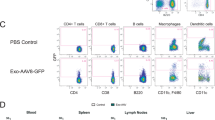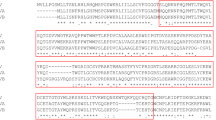Abstract
Gene transfer to primary cells, especially to lymphoid cells, using a nonviral delivery system has been very challenging. In the present studies, we have used a cationic polymer, polyethylenimine (PEI) coupled to an anti-CD3 antibody for achieving receptor-mediated gene delivery to human peripheral blood mononuclear cells (PBMC). Naive, unstimulated PBMC did not express transfected genes, whereas the transgenes were expressed efficiently in PHA activated PBMC. Transiently expressed gene products were detected maximally at 24 and 48 h following transfection. Gene expression was detected until 96 h with a gradual diminution in the signal after 48 h. Receptor-mediated gene delivery was successfully used for freshly isolated, as well as previously frozen lymphocyte samples. The transfections performed using ligands other than anti-CD3 were not as efficient as anti-CD3-PEI. These results suggest that in addition to receptor-mediated endocytosis, signaling subsequent to engagement of the CD3 receptor with anti-CD3-PEI appears to be important for the efficacy of anti-CD3-PEI mediated gene delivery.
This is a preview of subscription content, access via your institution
Access options
Subscribe to this journal
Receive 12 print issues and online access
$259.00 per year
only $21.58 per issue
Buy this article
- Purchase on Springer Link
- Instant access to full article PDF
Prices may be subject to local taxes which are calculated during checkout




Similar content being viewed by others
References
Hege KM, Roberts MR . T-cell gene therapy Curr Opin Biotechnol 1996 7: 629–634
Chernajovsky Y et al. Pathogenic lymphoid cells engineered to express TGF beta 1 ameliorate disease in a collagen-induced arthritis model Gene Therapy 1997 4: 553–559
Mullen CA et al. Molecular analysis of T lymphocyte-directed gene therapy for adenosine deaminase deficiency: long-term expression in vivo of genes introduced with a retroviral vector Hum Gene Ther 1996 7: 1123–1129
Bonini C et al. HSV-TK gene transfer into donor lymphocytes for control of allogeneic graft-versus-leukemia Science 1997 276: 1719–1724
Gallot G et al. Human HLA-specific T-cell clones with stable expression of a suicide gene: a possible tool to drive and control a graft-versus-host–graft-versus-leukemia reaction? Blood 1996 88: 1098–1103
Clay TM et al. Efficient transfer of a tumor antigen-reactive TCR to human peripheral blood lymphocytes confers anti-tumor reactivity J Immunol 1999 163: 507–513
Novak TJ, Yoshimura FK, Rothenberg EV . In vitro transfection of fresh thymocytes and T cells shows subset-specific expression of viral promoters Mol Cell Biol 1992 12: 1515–1527
Hughes CC, Pober JS . Transcriptional regulation of the interleukin-2 gene in normal human peripheral blood T cells. Convergence of costimulatory signals and differences from transformed T cells J Biol Chem 1996 271: 5369–5377
Quinn ER, Lum LG, Trevor KT . T cell activation modulates retrovirus-mediated gene expression Hum Gene Ther 1998 9: 1457–1467
Sharma S, Cantwell M, Kipps TJ, Friedmann T . Efficient infection of a human T-cell line and of human primary peripheral blood leukocytes with a pseudotyped retrovirus vector Proc Natl Acad Sci USA 1996 93: 11842–11847
Gallardo HF, Tan C, Ory D, Sadelain M . Recombinant retroviruses pseudotyped with the vesicular stomatitis virus G glycoprotein mediate both stable gene transfer and pseudotransduction in human peripheral blood lymphocytes Blood 1997 90: 952–957
Schnierle BS et al. Pseudotyping of murine leukemia virus with the envelope glycoproteins of HIV generates a retroviral vector with specificity of infection for CD4-expressing cells Proc Natl Acad Sci USA 1997 94: 8640–8645
Lodge R et al. MuLV-based vectors pseudotyped with truncated HIV glycoproteins mediate specific gene transfer in CD4+ peripheral blood lymphocytes Gene Therapy 1998 5: 655–664
Abe J et al. In vivo antitumor effect of cytotoxic T lymphocytes engineered to produce interferon-gamma by adenovirus-mediated genetic transduction Biochem Biophy Res Comm 1996 218: 164–170
Leon RP et al. Adenoviral-mediated gene transfer in lymphocytes Proc Natl Acad Sci USA 1998 95: 13159–13164
Chen JD et al. Intra- and extracellular immunization against HIV-1 infection with lymphocytes transduced with an AAV vector expressing a human anti-gp120 antibody Hum Gene Ther 1996 7: 1515–1525
Strayer DS, Kondo R, Milano J, Duan LX . Use of SV40-based vectors to transduce foreign genes to normal human peripheral blood mononuclear cells Gene Therapy 1997 4: 219–225
McMahon SB, Norvell A, Levine KJ, Monroe JG . Transient transfection of murine B lymphocyte blasts as a method for examining gene regulation in primary B cells J Immunol Meth 1995 179: 251–259
Cron RQ, Schubert LA, Lewis DB, Hughes CC . Consistent transient transfection of DNA into non-transformed human and murine T-lymphocytes J Immunol Meth 1997 205: 145–150
Cotten M, Wagner E, Birnstiel ML . Receptor-mediated transport of DNA into eukaryotic cells Meth Enzymol 1993 217: 618–644
Batra RK et al. Receptor-mediated gene delivery employing lectin-binding specificity Gene Therapy 1994 1: 255–260
Guy J, Drabek D, Antoniou M . Delivery of DNA into mammalian cells by receptor-mediated endocytosis and gene therapy Mol Biotechnol 1995 3: 237–248
Cristiano RJ . Targeted, nonviral gene delivery for cancer gene therapy Front Bioscience 1998 3: D1161–D1170
Buschle M et al. Receptor-mediated gene transfer into human T lymphocytes via binding of DNA/CD3 antibody particles to the CD3 T cell receptor complex Hum Gene Ther 1995 6: 753–761
Kircheis R et al. Coupling of cell-binding ligands to polyethylenimine for targeted gene delivery Gene Therapy 1997 4: 409–418
Abdallah B et al. A powerful nonviral vector for in vivo gene transfer into the adult mammalian brain: polyethylenimine Hum Gene Ther 1996 7: 1947–1954
Baker A et al. Polyethylenimine (PEI) is a simple, inexpensive and effective reagent for condensing and linking plasmid DNA to adenovirus for gene delivery Gene Therapy 1997 4: 773–782
Boletta A et al. Nonviral gene delivery to the rat kidney with polyethylenimine Hum Gene Ther 1997 8: 1243–1251
Boussif O et al. A versatile vector for gene and oligonucleotide transfer into cells in culture and in vivo: polyethylenimine Proc Natl Acad Sci USA 1995 92: 7297–7301
Coll JL et al. In vivo delivery to tumors of DNA complexed with linear polyethylenimine Hum Gene Ther 1999 10: 1659–1666
Goula D et al. Polyethylenimine-based intravenous delivery of transgenes to mouse lung Gene Therapy 1998 5: 1291–1295
Ringenbach L et al. Polyethylenimine-mediated transfection of human monocytes with the IFN-gamma gene: an approach for cancer adoptive immunotherapy Gene Therapy 1998 5: 1508–1516
Boussif O, Zanta MA, Behr JP . Optimized galenics improve in vitro gene transfer with cationic molecules up to 1000-fold Gene Therapy 1996 3: 1074–1080
Pollard H et al. Polyethylenimine but not cationic lipids promotes transgene delivery to the nucleus in mammalian cells J Biol Chem 1998 273: 7507–7511
Godbey WT, Wu KK, Mikos AG . Tracking the intracellular path of poly(ethylenimine)/DNA complexes for gene delivery Proc Natl Acad Sci USA 1999 96: 5177–5181
Wagner E, Cotten M, Foisner R, Birnstiel ML . Transferrin-polycation–DNA complexes: the effect of polycations on the structure of the complex and DNA delivery to cells Proc Natl Acad Sci USA 1991 88: 4255–4259
Puls RL, Minchin RF . Gene transfer and expression of a nonviral polycation-based vector in CD4+ cells Gene Therapy 1999 6: 1774–1778
Ebert O et al. Lymphocyte apoptosis: induction by gene transfer techniques Gene Therapy 1997 4: 296–302
Ebert O et al. TNF-alpha secretion and apoptosis of lymphocytes mediated by gene transfer Cytokines Cell Mol Ther 1999 5: 165–173
Smith CW et al. Recognition of an endothelial determinant for CD18-dependent human neutrophil adherence and transendothelial migration J Clin Invest 1988 82: 1746–1756
Author information
Authors and Affiliations
Rights and permissions
About this article
Cite this article
O'Neill, M., Kennedy, C., Barton, R. et al. Receptor-mediated gene delivery to human peripheral blood mononuclear cells using anti-CD3 antibody coupled to polyethylenimine. Gene Ther 8, 362–368 (2001). https://doi.org/10.1038/sj.gt.3301407
Received:
Accepted:
Published:
Issue Date:
DOI: https://doi.org/10.1038/sj.gt.3301407
Keywords
This article is cited by
-
All-in-one processing of heterogeneous human cell grafts for gene and cell therapy
Molecular Therapy - Methods & Clinical Development (2016)
-
In vivo growth inhibitory effect of iterative wild-type p53 gene transfer in human head and neck carcinoma xenografts using glucosylated polyethylenimine nonviral vector
Cancer Gene Therapy (2002)



